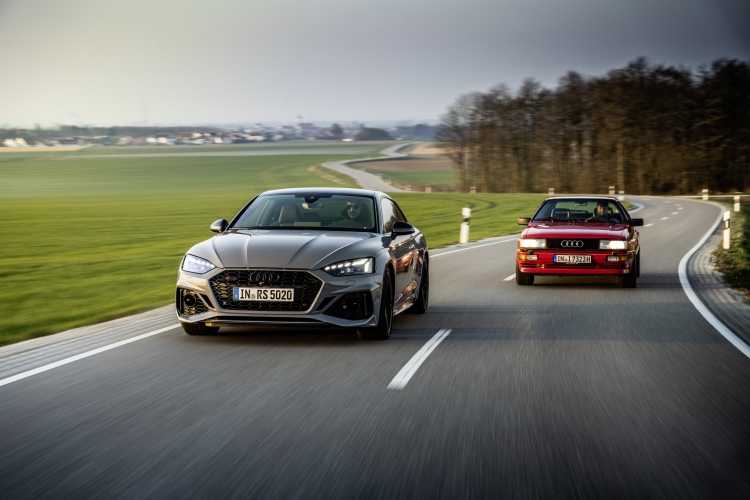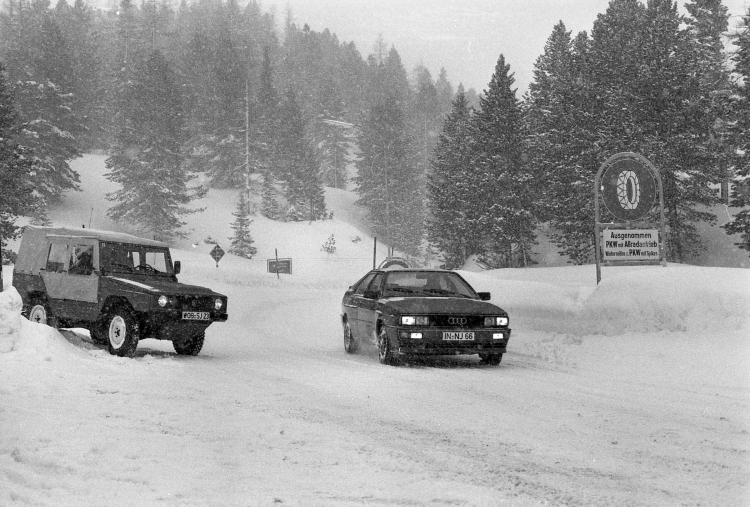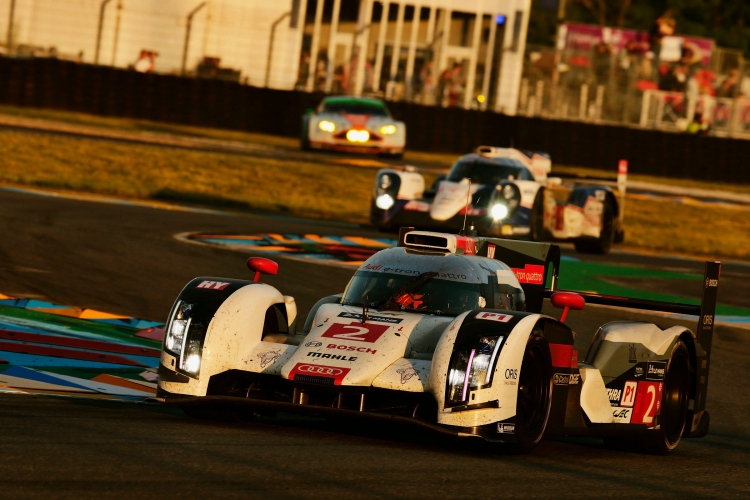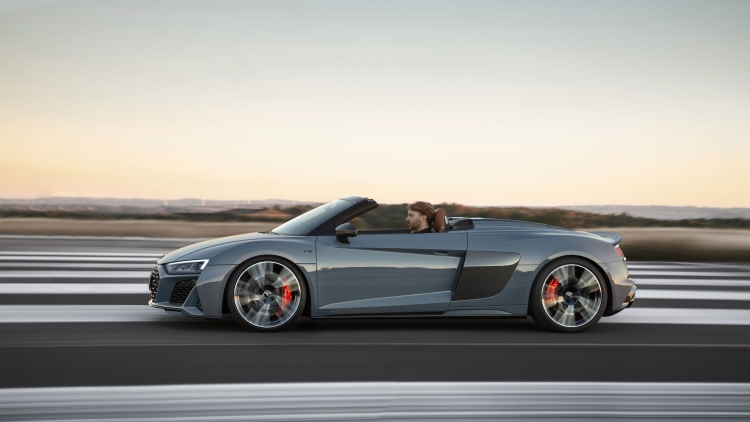40 years of quattro - The Audi story
A technology and success story from Audi is celebrating a major birthday: The quattro drive system has turned 40 years old. Here is the story of quattro from Audi.
quattro technology can trace its roots back to the winter of 1976/77, when a team of Audi engineers conducted a series of test drives in the deep snow of Sweden. A Volkswagen Type 183 aka Iltis (German for polecat) traveled along for comparison purposes, and the all-terrain military vehicle with its high ground clearance outperformed the much more powerful front-wheel-drive prototypes. During this trip, it dawned on the engineers that Audi could realistically use the all-wheel-drive system even on high-performance passenger cars - but it would have to be a completely new type that was lightweight, compact, and efficient, and could manage without a heavy transfer case or second propshaft.
The stroke of genius that made it all possible was the hollow-shaft - a drilled-out, 263 millimeters (10.4 in) secondary shaft in the transmission that directed power in two directions. From its rear end, it drove the housing of the center differential, which was configured as a manually locking bevel-gear differential. In normal situations, it sent 50% of the power along the propshaft to the rear axle, which was equipped with a second locking differential.
The other half of the torque was transferred to the front axle's differential along an output shaft rotating inside the secondary shaft. The quattro drive system was born. The center differential has evolved continuously since then.
Since 1980: quattro technology for longitudinal engines
The new technology made its first appearance at the Geneva Motor Show in 1980, fitted to the Audi quattro, an angular coupé with a five-cylinder turbocharged engine delivering 147kW (200PS). Originally planned for only low-volume production, the original quattro ended up remaining part of the model line-up until 1991, having undergone numerous refinements along the way. In 1984, it was joined by the Audi Sport quattro with a short wheelbase. Producing 225kW (306PS), it was an exclusive high-performance sports car at the time. With the new Audi 80 released in 1986, the brand introduced the second generation of its quattro technology, featuring the Torsen differential (Torsen: torque sensing), which was designed as a worm gear transmission.
The new differential was accompanied by an enormous technological advance and provided a technical basis that has undergone extensive further development and is still used today. When a vehicle axle lost traction, friction would be created in the helical gears of the differential, allowing up to 75% of the torque to be diverted to the other axle.
These higher locking figures enabled a clearly defined torque distribution in every driving situation. The next big step in the evolution of the models with longitudinal front-mounted engines came in 2005 with the Audi RS 4. The new planetary gearing distributed the forces in a rear-biased 40:60 ratio in normal conditions. This third generation of the center differential has undergone further stages of development since then. The current generation can distribute 85% of the drive torque to the rear axle and up to 70% to the front axle as needed.
1999 onward: new developments across all technical platforms
Audi has continued to expand its range of quattro models over the course of 40 years. The decision was made back in the early 1980s to offer the quattro drive system across the board. The new models helped to pave the brand's way into the premium segment. The first TDI with permanent all-wheel drive appeared in 1995; four years later, the technology moved into the compact class. The A3 and the new TT featured the electronically controlled hydraulic multi-plate clutch. The first generation of the Audi R8 high-performance sports car launched in 2007. Its quattro drive system was a very special development, with the transmission in the rear integrating a power take-off supplying an unregulated viscous coupling on the front axle via a propshaft. It could divert 15% to 30% of torque to the front wheels when conditions called for it.
In the second-generation version of the R8 (2015), the viscous clutch was replaced with a controlled multi-plate clutch. The sport differential for the powerful A and Q models came in 2008, making its debut in the Audi S4. Finally, the quattro system with ultra technology optimized for efficiency joined the technology line-up when it arrived in the AudiA4 in 2016. As the most recent major innovation in the mechanical quattro world to date, it solved the conflict of objectives between dynamic handling and efficiency. With the electric all-wheel drive and electric torque vectoring, Audi opened up a completely new chapter in technology history in the e-tron family in 2019.
quattro in motorsports
Audi entered the world of rallying as a works team in 1978, initially running front-wheel-drive cars. Barely a year had passed since the original quattro was first unveiled in Geneva then the brand began to achieve enormous success in the World Rally Championship. Hannu Mikkola of Finland won the first six special trials in the snow at the 1981 Monte Carlo Rally. He had a lead of almost six minutes when victory slipped through his fingers due to a minor accident. He recorded his first victory at the next round in Sweden.
1982–1987: supremacy on gravel
The following year, the quattro dominated the championship. Audi set a new benchmark with seven victories and easily won the manufacturers' championship. One year later, Mikkola took home the drivers' title. The 1984 season also started off with a bang - the newly recruited two-time world champion Walter Röhrl won the Monte Carlo Rally ahead of his teammates Stig Blomqvist (Sweden) and Mikkola. At the end of the season, Audi claimed both the manufacturers' title and the drivers' title with Blomqvist. To make better use of the loose regulations of the Group B class of rallying, Audi developed the Sportquattro for the 1984 season. This had a shorter wheelbase that promised nimbler handling.
It was followed in 1985 by the Sport quattro S1, which developed 350kW (476PS) and was instantly elevated to legendary status due in part to its striking rear spoiler. In the middle ratio, the 1,090-kilogram (2,403.0 lb) S1 shot from 0 to 100 km/h (62.1 mph) in 3.1 seconds. In the last event of the season, the British RAC Rally, Walter Röhrl used a dual-clutch transmission that was actuated pneumatically - a precursor to today's Stronic. When the exhilarating Group B years came to an end in 1986, Audi pulled out of the World Rally Championship - but not without one last bombshell.
In July 1987, Röhrl triumphed at the Pikes Peak hill climb, driving an extensively modified Sport quattro S1 adorned with some enormous wings. Michèle Mouton (France) and Bobby Unser (USA) had already won the classic race in the US State of Colorado in the two previous years. Walter Röhrl tackled the 19.99-kilometer (12.4mi) course, very little of which was paved at the time, in a record time of 10minutes and 47.85 seconds, hitting a top speed of 196km/h (121.8mph). As he noted, “It was the very pinnacle of what can be done with a rally car.”
1988-1992: success in touring car racing
The brand competed in the Trans-Am series in the USA with the Audi 200 in 1988, winning the manufacturers' and drivers' titles at the first attempt, the latter courtesy of US driver Hurley Haywood. Haywood and Hans-Joachim Stuck scored seven wins out of 15 races in the IMSA GTO series in 1989 when the regulations were a little more relaxed.
The five-cylinder turbo in their Audi 90 quattro hit top form at around 530 kW (720PS). Audi switched to the Deutsche Tourenwagenmeisterschaft (DTM) touring car championship in 1990. Stuck won the drivers' title with the big and powerful V8 quattro that first year, followed by Frank Biela in 1991. By the time Audi withdrew from the series in 1992, it had won 18 out of 36 races. In 1996, the Audi A4 quattro Supertouring, with its two-liter, four-cylinder engine, entered seven national championships on three continents - and won them all.
Because of its supremacy, the European rules largely banished all-wheel drive from touring car competition two years later. The quattro's record up to that point read as follows: four titles in the World Rally Championship, three victories at Pikes Peak, a championship win in the Trans-Am, two DTM titles, eleven national touring car championships, and a World Touring Car Cup.
2012–2014: three overall victories at Le Mans
It wasn't until 2012 that an Audi all-wheel-drive race car - the Audi R18 e-tron quattro with hybrid drive - once again took to the track for a circuit race. A V6 TDI drove the rear wheels, while a flywheel accumulator supplied recuperated energy to two electric motors on the front axle. When the situation called for maximum traction during acceleration, the racing car was capable of throwing its temporary quattro drive system into the mix for a few crucial seconds.
With three consecutive overall victories at the 24 Hours of Le Mans and two drivers' and manufacturers' titles in the World Endurance Championship (WEC), Audi provided a convincing demonstration of the potential of the concept.


























